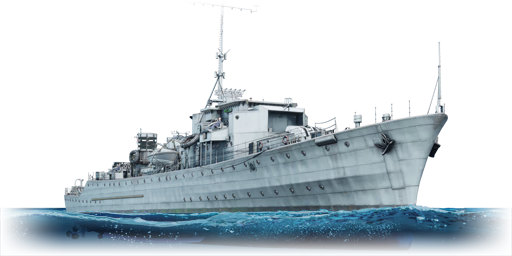



The HMS Brissenden is a British destroyer. It was introduced in Update 1.95 "Northern Wind".
HMS Brissenden, pennant number L79, part of the Hunt-class, is an escort destroyer completed and sent into service in 1943 with the Royal Navy's Home fleet. The Brissenden (Series IV) is an improvement in the Hunt-class. At glance, without much difference in the armament and design layout, but actually with several noteworthy differences.
The slow-paced fast-firing support gameplay won't vary as much, but there is now the possibility to launch a modest number of torpedoes. Anti-air armament was increased, along the crew needed to man this new equipment. Those modifications in armament and design also caused a slight tonnage increase in the displacement and thus an even lower top speed. In spite of all these downsides, the Hunt-class remains a cunning adversary.
| Ammunition | Type | Armor penetration (mm) at a distance: | |||||
|---|---|---|---|---|---|---|---|
| 1000 m | 2500 m | 5000 m | 7500 m | 10000 m | 15000 m | ||
| HE | 20 | 20 | 20 | 20 | 20 | 20 | |
| SAP | 101 | 83 | 60 | 44 | 33 | 26 | |
| HE-TF | 20 | 20 | 20 | 20 | 20 | 20 | |
| HE-VT | 20 | 20 | 20 | 20 | 20 | 20 | |
| Belt | Belt filling | Armor penetration (mm) at a distance: | |||||
|---|---|---|---|---|---|---|---|
| 10 m | 100 m | 500 m | 1000 m | 1500 m | 2000 m | ||
| HEF/AP-T/HEF/AP-T | 60 | 57 | 50 | 43 | 38 | 34 | |
| HEF/HEF/HEF/AP-T | 60 | 57 | 50 | 43 | 38 | 34 | |
| AP-T/AP-T/AP-T/HEF | 60 | 57 | 50 | 43 | 38 | 34 | |
| Belt | Belt filling | Armor penetration (mm) at a distance: | |||||
|---|---|---|---|---|---|---|---|
| 10 m | 100 m | 500 m | 1000 m | 1500 m | 2000 m | ||
| HEF-T/AP-T | 34 | 32 | 26 | 21 | 18 | 16 | |
4 × Y-gun Mk.VII depth charge











Seakeeping |
|---|
Unsinkability | |
|---|---|
Firepower | ||
|---|---|---|